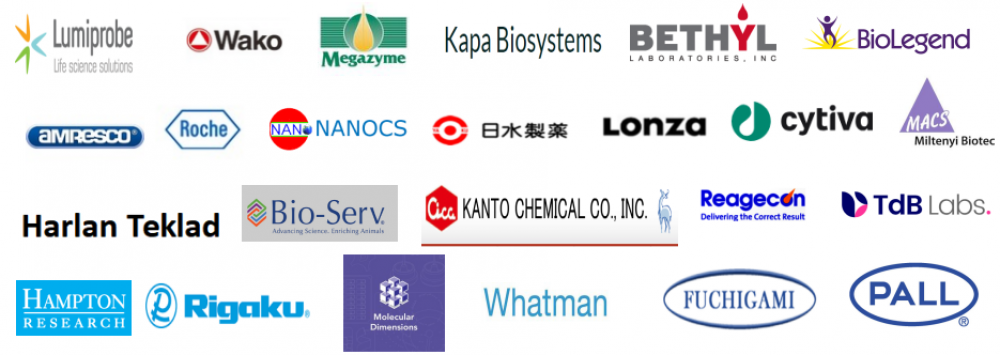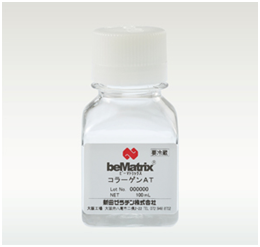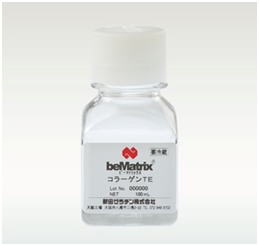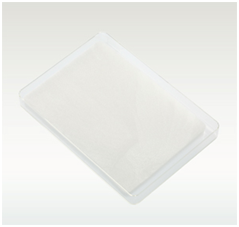描述
搜索关键词:
Extracellular Matrix (ECM) 细胞外基质;Gelatin 明胶;Collagen Type I 胶原蛋白I型;Poly-L-lysine 多聚L-赖氨酸;Fibronectin 纤连蛋白;Matrigel 基质胶;CAS:9007-34-5;
产品信息:
| 产品名称 |
产品编号 |
规格 |
价格(元) |
| Collagen, Type I, from Rat Tail 鼠尾胶原蛋白I |
MX0910-2ML |
2ml (10mg) |
450 |
| Collagen, Type I, from Rat Tail 鼠尾胶原蛋白I |
MX0910-10ML |
10ml (50mg) |
2000 |
基本介绍:
胶原蛋白是结缔组织和内脏器官细胞外基质的主要构造成分,但在皮肤、肌腱、骨骼中分布最为广泛。从遗传和结构上胶原蛋白分为许多类型。胶原蛋白I(Collagen, Type I)是由2个α1链和1个α2链组成的异源多聚体,在37℃,中性pH下自发形成三螺旋骨架,是一种优秀的细胞培养用基质,广泛用于肝细胞、成纤维细胞、脊神经节、肌肉细胞、施万细胞、胚肺细胞、上皮细胞和其他大量细胞系。还能用于研究细胞生长、分化、迁移以及发育过程中的组织形态发生。
金畔生物提供的鼠尾胶原蛋白I是根据Birkedal-Hansen方法,通过醋酸抽提、氯化钠沉淀、磷酸氢二钠沉淀等步骤制备。可用于包被细胞培养器皿,培养细胞表面粘附性,特别适合那些在普通培养器皿表面不易贴壁的细胞,比如成纤维细胞、肝细胞等原代细胞。还可用于三维胶的制备,模拟真实的生长环境,使得细胞在三维环境中生长。
本品为溶于6mM HAc的无菌溶液,浓度5mg/ml,每个批次产品皆通过细胞培养测试(包括三维空间培养)以保证质量的可靠性。
保存与运输方法:
保存:2-8℃保存,不可冻存,一年有效。
运输:冰袋运输。
注意事项
1)整个操作请于冰上进行,因室温鼠尾胶原I可迅速成胶,操作过程尽量保持低温。
2)整个操作请在无菌环境下无菌操作,避免污染以影响细胞生长。
3)为了您的安全和健康,请穿实验服并戴一次性手套操作。
使用方法
1. 细胞培养器皿的表面包被
组织培养器皿的表面包被推荐浓度为1-5µg/cm2,起始浓度可首选5µg/cm2。建议根据具体细胞类型来优化。
1.1 6mM HAc稀释液的制备
本品以溶于6mM HAc(=0.36g/L HAc)的无菌溶液形式提供,本身不溶于中性pH,建议用6mM HAc溶液做进一步稀释。
配制方法:取34.5µl冰醋酸(17.4 M)加入100ml双蒸水,充分混匀后即得到6mM HAc溶液,0.22µm滤膜过滤除菌后待用。
1.2 包被步骤
a,根据自身实验体系以及优化后的包被浓度来计算所需的胶原蛋白量,并加入相应孔内,确保胶原蛋白溶液完全覆盖表面。
1)以包被浓度为5µg/cm2,先用6mM HAc稀释液将胶原蛋白(5mg/ml)稀释到合适的中间浓度,如50µg/ml,然后参考表1不同培养皿内胶原蛋白加量表来加量到各孔内;
2)以包被浓度为2µg/cm2,先用6mM HAc稀释液将胶原蛋白(5mg/ml)稀释到合适的中间浓度,如12µg/ml,然后参考表1不同培养皿内胶原蛋白加量表来加量到各孔内;
表1 不同培养皿内胶原蛋白加量表
| 培养皿类型 |
每孔/皿表面积(cm2) |
当包被浓度:2µg/cm2,中间稀释浓度:12µg/ml,加入该稀释液的体积(µl) |
当包被浓度:5µg/cm2,中间稀释浓度:50µg/ml,加入该稀释液的体积(µl) |
| 96 well |
0.3 |
50 |
30 |
| 24 well |
1.9 |
300 |
190 |
| 12 well |
3.8 |
600 |
380 |
| 6 well |
9.5 |
1580 |
950 |
| 35mm |
8 |
1330 |
800 |
| 60mm |
21 |
3500 |
2100 |
| 100mm |
55 |
9170 |
5500 |
b,室温孵育1h,小心吸掉多余液体,用无菌PBS清洗3~4次后直接使用。或者加完胶原蛋白溶液后,在超净台内开盖过夜晾干。无菌条件下,包被好的器皿在4-25℃至少可保存3个月。
2. 三维胶原的制备
当鼠尾胶原蛋白I使用浓度>1mg/ml,pH 7.0左右皆可形成具有一定强度的三维胶,建议成胶浓度为1-2 mg/ml。
由于本品是以溶于6mM HAc的无菌溶液形式提供,在成胶过程需先加入0.06倍体积的0.1M NaOH中和。
2.1 需要溶液准备(无菌、预冷)
10×PBS(可含酚红)或10×细胞培养液
0.1M NaOH
双蒸水
2.2 三维胶原制备(不含细胞)(以配制1ml,1mg/ml三维胶为例):
a,取200µl胶原蛋白(5mg/ml)加到置于冰浴的离心管内,加入690µl无菌水。之后加到12µl 0.1M NaOH【注意:该步骤不能反,如果反过来把12µl 0.1M NaOH加到胶原溶液中,会由于NaOH不能迅速混匀而产生局部的胶原凝结】,立即混匀。再加入100µl 10×PBS或10×细胞培养液,混匀后立即加到培养器皿中【注意:混匀后pH为7.0左右,如果PBS或培养液中没有加酚红,初次使用时需要用pH试纸测试】。
b,将培养器皿在室温(25℃左右)放置20min待胶凝固后,转移到培养箱内。【注意】:如果配制中使用的是10×PBS,需要在做细胞培养前,先加入适当体积的细胞培养液预平衡。
2.3 三维胶原制备(含细胞)(以配制1ml,1mg/ml三维胶为例):
a,准备好细胞悬液,并放置于冰浴中。
b,将200µl胶原蛋白(5mg/ml)加到12µl 0.1M NaOH【注意:该步骤不能反,如果反过来把12µl 0.1M NaOH加到胶原溶液中,会由于NaOH不能迅速混匀而产生局部的胶原凝结】,立即混匀。再加入23µl 10×PBS或者10×细胞培养液,立即混匀【注意:混匀后pH为7.0左右,如果PBS或培养液中没有加酚红,初次使用时需要用pH试纸测试】。再加入760µl的细胞悬浮液,混匀后立即加到培养器皿中。
c,将培养器皿在室温(25℃左右)放置20min待胶凝固后,加入适当体积细胞培养液,转移到培养箱中培养。
相关产品:
| MX0910-2ML |
Collagen, Type I, from Rat Tail 鼠尾胶原蛋白I |
2ml(10mg) |
| MX0911-100G |
Gelatin, Type A 明胶(A型) |
100g |
| MX0917-25MG |
Poly-L-lysine (Mw 70,000-150,000) 多聚L-赖氨酸 |
25mg |
| MX0918-25MG |
Poly-L-lysine (Mw 150,000-300,000) 多聚L-赖氨酸 |
25mg |
| MX0921-25MG |
Poly-D-lysine (Mw 70,000-150,000) 多聚D-赖氨酸 |
25mg |
| MX0918-25MG |
Poly-L-lysine (Mw 150,000-300,000) 多聚L-赖氨酸 |
25mg |
| MX0922-10MG |
Poly-D-lysine (Mw 150,000-300,000) 多聚D-赖氨酸 |
10mg |
| MX0926-5MG |
Fibronectin from Human Plasma 人纤连蛋白 |
5mg |
| MX0928-1MG |
Laminin from Mouse EHS sarcoma小鼠层粘连蛋白 |
1mg |



